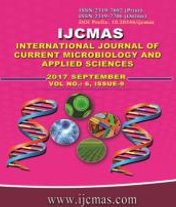


 National Academy of Agricultural Sciences (NAAS)
National Academy of Agricultural Sciences (NAAS)

|
PRINT ISSN : 2319-7692
Online ISSN : 2319-7706 Issues : 12 per year Publisher : Excellent Publishers Email : editorijcmas@gmail.com / submit@ijcmas.com Editor-in-chief: Dr.M.Prakash Index Copernicus ICV 2018: 95.39 NAAS RATING 2020: 5.38 |
The process of evaporation is influenced by a number of factors, the most common and important meteorological parameters affecting evaporation are solar radiation, temperature, relative humidity, wind speed and atmospheric pressure. There are number of models for the estimation of evaporation developed by investigators in different fields of study. The interrelated factors are incorporated into various formulae for estimating evaporation. Due to complex interactions between the components of the land-plant-atmospheric systems the reliable estimation of evaporation are extremely difficult. The objective of this study was to develop an evaporation model for the K.C.A.E.T. campus, Tavanur using Artificial Neural Network (ANN) technique and MATLAB software. Monthly observations of meteorological parameters during the period February 2003 to January 2009 collected were used for the model development. The entire data is divided into three categories as pre-monsoon observations, monsoon observations and post monsoon observations. So each category consists of 24 observations of each parameter. From this study, it could be seen that the wind speed had greater influence on the evaporation rate during all seasons. Out of the five strategies considered for the study, the strategy with wind speed, dry bulb temperature and wet bulb temperature (strategy M- 3) was found to be the accurate combination for the estimation of evaporation during all the seasons with comparatively least MSE and high R2 value when compared with other strategies. Hence, it can be concluded that the combination of wind speed, dry bulb temperature and wet bulb temperature has great influence on the evaporation during all seasons.
 |
 |
 |
 |
 |